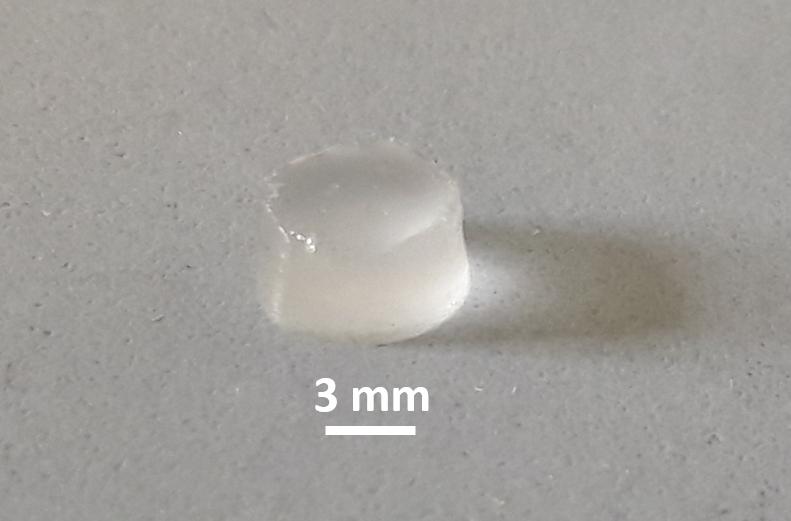

The novel biomaterial could be used for implants in the field of regenerative medicine. The Kiel research team wants to test the marketability of the special hydrogel, using the EU grant received.
Copyright: Christine Arndt
It is being funded by the European Research Council with a so-called Proof of Concept Grant. It aims at putting the results of fundamental research into practice and amounts to 150,000 Euros.
How cells behave also depends on their environment. Via receptors on their surfaces they identify mechanical stimuli from their environment like the contact to others cells or surfaces. They convert this information into biochemical activity and start to divide, differentiate or move.
Christine Selhuber-Unkel, professor for biocompatible nanomaterials, and her team have developed a material to imitate this cellular mechanism called mechanotransduction. With the help of the material they can control the behaviour of cells. “Due to its similarity to the natural cell environment it can be used as an implant in the field of regenerative medicine, or for storing cells for stem cell therapy”, says the materials scientist.
Now, with the grant from the European Research Council, Selhuber-Unkel and her team want to make the material ready for the market. “Together with potential customers, we want to determine the specific demand for our material, and develop it accordingly. To do so, we have close links with different spin-offs from the CAU, and will contact other companies,” announced Selhuber.
The expected outcome of the project is to receive a biocompatible prototype of the material, which can be fabricated cost-effectively in different levels of complexity. To put the results of fundamental research into practice quickly and to strengthen technology transfer is exactly the aim of the initiative of the European Research Council.
“As a university, we want to solve social problems and directly improve peoples’ lives. This is why we’re working on putting our research findings into practice faster. The project gives us impulses as to how this transfer can take place better and more on-target in the future”, Vice President Professor Karin Schwarz, responsible for research and technology transfer at the CAU, is delighted about the first approved funding of this type in Schleswig-Holstein.
A special feature of the new biomaterial is the interconnected hollow channels of only a few micrometres in diameter. They run throughout the soft hydrogel like a system of narrow corridors. This structure is similar to the framework of proteins cells in the human body are surrounded by. When cells are placed in these tunnels within the hydrogel, they react via their surfaces to material around them. “The main advantage of our material is the fact that we can specifically adjust the size of the channels and their arrangement when manufacturing it. This way we can precisely influence the reaction of the cell and let it grow, for example”, says Selhuber-Unkel.
The strong efficacy of the material is even enhanced by its three-dimensionality.
Placed in the fine channels the cells are surrounded by the hydrogel. Thus, approximately 80 percent of the surface of the cell is in contact with the polymer material – far more than in the case of flat environments that only touch about 50 percent of the cell surface. “More contact means more influence on cells,” explained Selhuber-Unkel one of the underlying principles of the project “Channelmat” (a combination of “channel” and “material”).
The project is the result of a cooperation between Kiel University’s priority research area Kiel Nano, Surface and Interface Science and the Functional Nanomaterials working group led by Professor Rainer Adelung. The CAU scientists have already registered a patent for their special material.
Photos are available for download under:
http://www.uni-kiel.de/download/pm/2017/2017-362-1.jpg
Caption: Christine Selhuber-Unkel (right), Mohammadreza Taale and Christine Arndt from the Institute for Materials Science at Kiel University colonise the new biomaterial with cells in the laboratory at the Faculty of Engineering.
Photo: Siekmann/CAU
http://www.uni-kiel.de/download/pm/2017/2017-362-2.png
Caption: The novel biomaterial could be used for implants in the field of regenerative medicine. The Kiel research team wants to test the marketability of the special hydrogel, using the EU grant received.
Copyright: Christine Arndt
http://www.uni-kiel.de/download/pm/2017/2017-362-3.jpg
Caption: The hollow channels can be seen on the surface of the new biomaterial. These channels are connected to each other throughout the interior. The soft material mimics the cell environment and influences the behaviour of cells.
Copyright: Katharina Siemsen
Information on the Proof of Concept grant
Since 2007, the European Research Council of the EU has funded excellent fundamental research. With the Proof of Concept grant, innovative research ideas from projects already funded by the European Research Council should be tested for their applicability, and be developed further for the market. The grant, amounting to 150,000 Euros per project, can be used for such things as market research, feasibility studies, or creating a business plan. With the Proof of Concept grant, the European Research Council aims to close a gap between fundamental research and the first phases of application.
More information: https://erc.europa.eu/funding/proof-concept
Contact:
Professor Christine Selhuber-Unkel
Biocompatible Nanomaterials
Institute for Materials Science
Tel.: +49 431 880 6198
E-mail: cse@tf.uni-kiel.de
Kiel University
Press, Communication and Marketing, Dr Boris Pawlowski, Text/editing: Julia Siekmann
Postal address: D-24098 Kiel, Germany,
Telephone: +49 (0)431 880-2104, Fax: +49 (0)431 880-1355
E-mail: presse@uv.uni-kiel.de, Internet: www.uni-kiel.de, Twitter: www.twitter.com/kieluni Facebook: www.facebook.com/kieluni, Instagram: instagram.com/kieluni
Details, which are only a millionth of a millimetre in size: This is what the priority research area “Kiel Nano, Surface and Interface Science – KiNSIS” at Kiel University has been working on. In the nano-cosmos, different laws prevail than in the macroscopic world – those of quantum physics. Through intensive, interdisciplinary cooperation between materials science, chemistry, physics, biology, electrical engineering, computer science, food technology and various branches of medicine, the priority research area aims to understand the systems in this dimension and to implement the findings in an application-oriented manner. Molecular machines, innovative sensors, bionic materials, quantum computers, advanced therapies and much more could be the result.
More information at www.kinsis.uni-kiel.de












